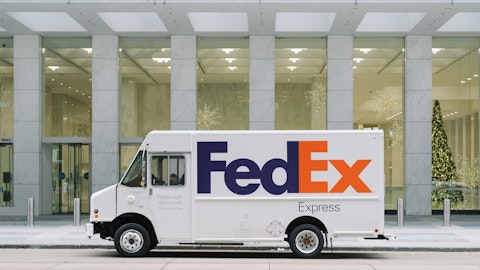And the answer increasingly is, well, if we can serve you an interesting relevant ad and it has to be both of those things, then you’ll actually tend to watch it, which is why our — and then often you’ll act as a result. So, our click-through rate, I think I’m getting this right, is about 10 times the average. We just introduced video ads too and those are particularly interesting to people because short-form video when well done, turns out to be incredibly engaging. So, all that’s a long way of saying, I think there’s a lot of — and then, of course, we have first-party data, right? We know where you’re going as a rider. And so you may have seen some of the tests we’re doing now, a number of tests we’re doing in the background that kind of know either where you’re going or the type of place you might want to go and maybe we’ll give you a coupon to go there.
So, it’s a long way of saying, I think there’s a lot of opportunity here. I think it’s quite accretive. I think it’s a good customer experience. A good partner experience for sure, they’re getting good value. And then, to the driver point, we pay our drivers when advertising happens, particularly when it’s on a tablet. But more generally, it allows us to have more margin to sort of play it back to drivers. And so — and that’s simply one of many ways. And I’ll flip to drivers and stop. You know, we’re so focused now, and I think this really is sort of a manifestation of our customer-obsessed strategy of saying how can drivers earn more? How can drivers earn more, right? There is a ceiling, right? The ceiling is called the fare that a rider pays, right?
Well, I guess, plus media if you want to go crazy. But we have to take a little bit of money to operate the platform. We got to pay insurance and so forth on. So, then the question is, well, how can drivers earn more? And the answer is they can get more rides. Those rides can be more profitable for them because maybe you know, media or other sorts of things. They could be positioned closer to riders as opposed to long pickups because they — the pay tends to favor them a little bit that way. We can negotiate on their behalf for better gas prices. We actually do this. We’ve got a program that gives you $0.25 up to $0.30 I think off gallon of gas for certain things. So, there are all sorts of things we can do that increase drivers both gross and net earnings.
And we are really taking a sort of whole company approach to make sure that we can do that because we know the more drivers we have and the happier they are, the brighter preference they have, the more they’ll come back. So, I know we covered a whole lot there, but hope that gives you some insight.
Michael Morton: Thank you so much.
David Risher: Sure.
Operator: Your next question comes from Doug Anmuth with JPMorgan. Please go ahead.
Doug Anmuth: Thanks for taking the questions. Just given the strong supply in the marketplace, can you just talk about how you think about the efforts to drive the 40 million annual users higher versus increasing frequency among the quarterly active rider base that’s roughly half that number? And then, separately, you’ve often highlighted partnerships and I know that remains a key priority for ’24. We’ve seen some industry activity on that front. I’m just curious how you’re thinking about opportunities in adjacent categories. Thanks.
David Risher: Yes. Maybe I’ll take that one. And then, Erin and I can tag team on that if we want to. So, okay, I remember the partners — oh yes, yes. So, a couple of data points. So, on active riders. So, you’re absolutely right, Doug, of course, to sort of distinguish between a new rider and an existing rider and kind of what that looks like. And just to emphasize one quick point, we mentioned it briefly, our active riders — total active riders were up about 12% year-on-year, which is the strongest growth rate we’ve had in six quarters. So, that’s great news, right? Because that shows that we’re an attractive proposition to people day-in and day-out. That’s awesome. Now, where we have actually seen more — so — and both matter, right?
So, new and existing, they both matter. There’s — you can’t — you don’t get to choose just one out of two. Our focus strategically over the last year has actually been more on driving frequency. And the reason that is true is because this is something actually Scott Cook at Intuit said years ago. He said, first you have to — first you have to work on the — do the right things and you have to do it right. So, doing the right thing meant getting driver pay right, getting pricing right, getting ETAs down to a great point and so forth. Because if you don’t get that right, then you’re going to bring a bunch of new people on the platform and they’re just going to churn out. So, we’ve done exactly the right thing. We’ve really focused on that operational excellence to get to the point where we are providing a very, very good experience.
I’d say, objectively, significantly better if you look at ETA times and so forth than a year ago. So — and we’ve seen the results. Our frequency is actually increasing quite significantly, which is wonderful. It’s a really good indicator, early indicator. When your heaviest users are using you even more then you’re doing something right. And they’re the ones that have the most exposure to what you’re doing. And so, then, over-time, the focus can kind of broaden to how can we start to attract new people to the platform. And there are many ways to do that. Some of them are very familiar to all of us, referral bonus and so on and so forth. Others are maybe a little more innovative and those are some things we’re sort of cooking up in the background.
But that leads me very naturally, I think, to your second point around partnerships. I think here’s another — it’s full of chestnuts today. So, I used to spend a lot of time in Africa. And Africa, a lot of the countries there have this little saying that says, if you want to go fast, you go alone, but if you want to go far, you go together. And so, in order for us to go far in our customers’ lives, riders’ lives in particular, I would say partnerships really matter, right? Because people have complicated lives. They take airplanes. They do all sorts of other things. And so, we will continue to invest in our partnership strategy. It’s been one that we’ve been working on for years and you’ll see a lot more. I don’t have anything particular to announce there, but I will certainly say, again, just sort of almost schematically partnering with someone who is values aligned and kind of customer-obsessed aligned partner, can be really helpful because it can mean that we can get new riders that way.
Doug Anmuth: Thank you, David.
Operator: Your next question comes from Benjamin Black with Deutsche Bank. Please go ahead.
Benjamin Black: Great. Thank you for taking my question. You know, obviously, there have been quite a few moving pieces related to sort of the regulatory backdrop. You know, you had the ballot proposal in Massachusetts, Minneapolis issue, and then obviously the looming Supreme Court decision on Prop 22 in California. So, I guess the question is how do you feel positioned for these upcoming challenges and sort of what’s your strategy if potential reclassification is required? And then, just one on mix of mode. I think you mentioned this as one of the potential drivers of improvements in your gross margin profile over-time. Just can you dig into a little bit of the progress there? You know, can you give us some examples of some of the strategies that are showing sort of notable progress? Thank you.





